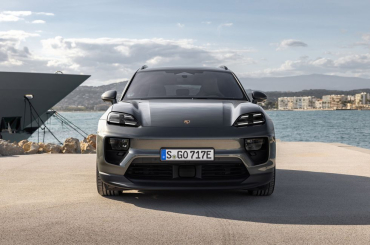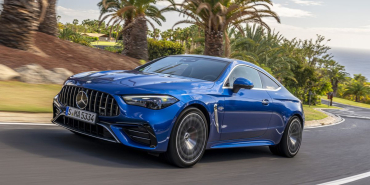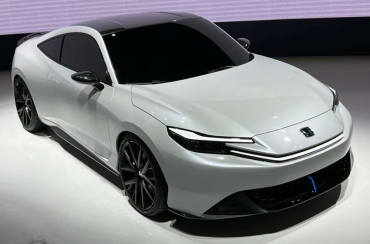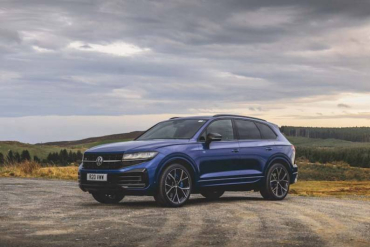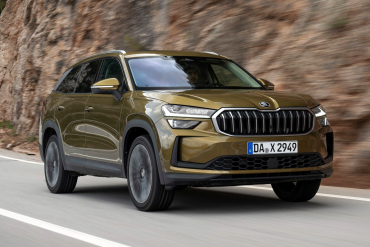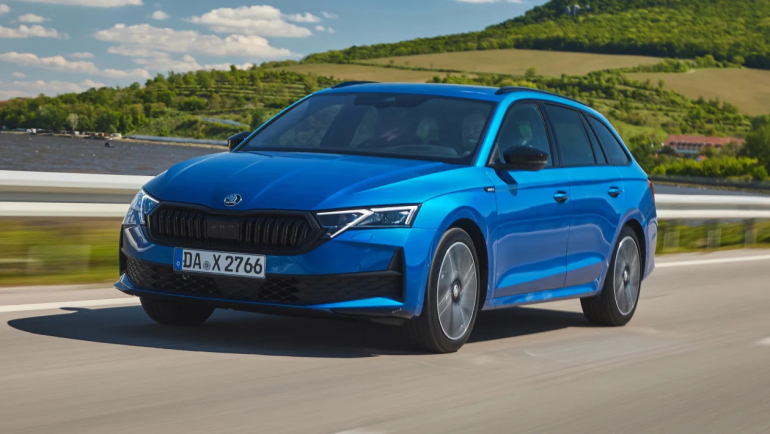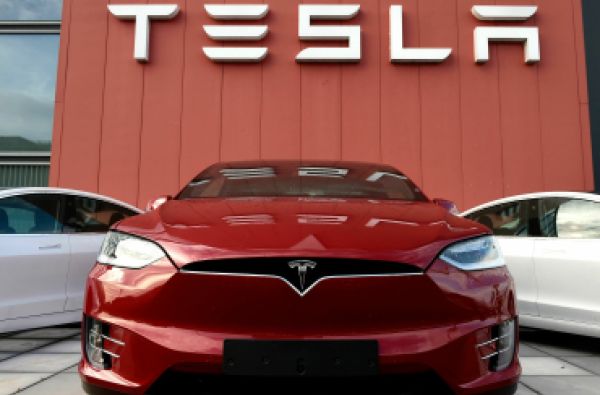
Worldcarblog.com
Tesla lowers car prices in Europe as well
The company Tesla has announced a big reduction in the prices of its vehicles in China and Germany, not long after it did so in the United States of America.
The latest price cut is another attempt for Ilona Musk's company to deal with declining sales and increasingly strong competition in leading markets, reports CNN.
The drop in prices reduced Tesla's profit margins, which also led to a drop in its shares by about four percent.
The world's largest manufacturer of electric vehicles on Sunday reduced the starting prices of four models in China, its largest overseas market, by 14,000 yuan, or about 1,810 euros.
The Model I, Tesla's best-selling car in China, is now on sale at an all-time low of 249,900 yuan (€32,384).
In Germany, Tesla's biggest market in Europe, the price of the rear-wheel drive Model 3 has also been reduced by 2,000 euros to 40,990 euros, according to the official website.
The first cuts were announced in the US on Friday, when Musk's company lowered the prices of three of its five models.
Tesla shares have fallen more than 40 percent since the start of the year, after quarterly car shipments fell for the first time in nearly four years, and the company also announced layoffs of about 10 percent of its workforce worldwide.
New Skoda Octavia Estate 2024 review: facelifted family wagon shines
The Skoda Octavia is at its most practical in estate form and there’s still a diesel for the real traditionalists
Verdict
We’d like to think there’s still a place in this world for a diesel wagon, and the updated Skoda Octavia Estate is a fine example of the breed. It has more than enough space for most use cases, and a plusher, better-equipped cabin than before. We’d stick with cheaper regular versions over Sportline for a more comfy ride because if anything, the revised kit lists have pushed the big-value sweet spot slightly further down the range. And as before, the Octavia Estate plays best as a ultra-capable, long-distance, comfy cruiser. At this game, there are few that can truly rival it.
The Skoda Octavia is known in the UK as a Volkswagen Golf and Ford Focus rival – but it’s actually a bigger seller as an estate – marginally so in the UK, and overwhelmingly so across continental Europe. The model as a whole is a core product for Skoda, despite its proliferation of SUVs and big plans for all-electric models. So the stakes are high for this new facelifted version of the Skoda Octavia Estate.
The wagon gets the same basic upgrades as its hatchback cousin – which add up to a neat bit of restyling and some useful additions to the standard kit list. The new design extends to revised daytime-running lights and matrix-LED headlights, a more sophisticated front bumper with cleaner surfacing, new tail-lights with animated ‘welcome’ functionality and some fresh alloy wheels and colour options.

There’s a notable tweak in the Octavia engine line-up, where the previous three-cylinder 1.0-litre petrol motor has been dropped in favour of a slightly more powerful 1.5–litre four-cylinder unit. It produces 114bhp and 220Nm of torque, and is available, depending on trim level, as a cheaper alternative to the usual 1.5-litre 148bhp motor. Both of these engines get a six-speed manual gearbox as standard, but you can have them both with a seven-speed dual-clutch auto too – and that version comes with 48-volt mild-hybrid assistance to help improve fuel economy.
Perhaps more significantly for the load-lugging estate car market, Skoda continues to offer the Octavia Estate with a couple of diesel options – a 2.0-litre motor in two states of tune, 114bhp and 148bhp. A six-speed manual is the standard gearbox on the lower-powered version, while the more potent configuration – the car we’re driving here – gets the seven-speed automatic, but does without the petrol model’s hybrid tech.
On the road, the 2.0 TDI does a terrific job of reminding you how effective a diesel powertrain can still be – deserving of far more sales, in fact, than it’s likely to get, given market trends. There’s more than 120Nm of additional torque here compared with the 1.5-litre 148bhp petrol, and even with the load bay relatively empty, you can certainly feel it. There’s more than enough shove from less than 1,500rpm and in general, you’re done and dusted and up to the next gear before 2,700rpm, with the minimum of fuss.

This, in turn, means that the gearbox is hopping around all over the place, but most of the time, it manages to perform the necessary manoeuvres smoothly and slickly. It’s best at a cruise, really, although if you do decide to ramp up the pace and use the (cheap-feeling) shift paddles at the rear of the steering wheel, it’ll perform snappily. It’s at low speeds, as usual, where DSG can be exposed, with the occasional jerky shift or flare-up of driveline shunt – but these are relatively rare.
Even so, there’s no doubt that this engine makes the most sense if you’re planning to properly fill the Octavia Estate’s boot and/or all of its seats. It’s more than fast enough and those reserves of low-down torque mean you’ll rarely have to rev the engine beyond its usual slightly raspy, but generally inoffensive drone.
The heavier engine makes the diesel Octavia perhaps a teeny bit more nose heavy, but its steering, handling and composure remain assured, if uninvolving. The best you can hope for, really, is the satisfaction of stroking the car down a fast, flowing road, because it will come unstuck by its own size and mass (as well as the gearbox) if you try to fling it around on twistier routes.
The body control is probably a little more focused in the Sportline edition we’re trying here. It gets suspension lowered by 15mm and 18-inch alloys as standard, but it wouldn’t be our top pick from the range, frankly; it’s not uncomfortable but there’s an undeniable murmur from beneath you, as the car picks up more road imperfections than any of its more conventionally set up stablemates would.
There’s a bit more road noise transmitted, too; we’d be inclined to stick with an SE L wagon on 17-inch wheels instead. Unless, that is, you’re desperate to have the slightly sportier look, achieved through gloss-black trim elements and more aggressive bumpers.
It’s not as if the more modest Octavias want for standard kit anyway, thanks to useful upgrades introduced with this facelift. The entry point for the range, SE Technology, gets a whopping 13-inch infotainment screen, front and rear parking sensors, heated front seats and a plethora of high-powered USB-C ports – as well as 16-inch alloy wheels. It’s available with both diesels but only the lower-powered petrol.
The SE L steps up to 17-inch wheels (not an issue for comfort, based on our experience with a pre-facelift car) and brings animated LED tail-lights, heating on the (two-spoke) steering wheel and windscreen, and a powered tailgate with gesture control. This is offered with both diesels again, but only the higher-powered petrol. And the Sportline driven here is restricted to just the high-powered petrol, in manual form, and the 148bhp diesel auto.
The sheer amount of cabin and boot space have always been key qualities of the Skoda Octavia Estate, and they remain so here – but are joined by plush, well-judged finishes across the entire range. The Estate boot comes in at a whopping 640 litres with the rear seats in place, and you can boost this to 1,700 litres by folding down the second row; either way, you’ve a capacity that trumps those of the Octavia’s obvious Stellantis competitors, the Vauxhall Astra Sports Tourer and the Peugeot 308 SW.
Neither of those cars is available with a diesel option, though they are offered with the choice of a plug-in hybrid powertrain that could make them more appealing to company-car choosers. Skoda has elected not to include a PHEV in the Octavia range – but the tech is available within the wider VW Group and with the way the market is going, the smart money is on one arriving within the next 18 months.
Model: Skoda Octavia Estate 2.0 TDI DSG Sportline
Price: £32,700
Engine: 2.0-litre 4cyl turbodiesel
Power/torque: 148bhp/360Nm
Transmission: Seven-speed dual-clutch auto, front-wheel drive
0-62mph: 8.6 seconds
Top speed: 139mph
Fuel economy: 61.2mpg
CO2 emissions: 121g/km
L/W/H: 4,698/1,829/1,486mm
Source: autoexpress.co.uk
2024 Porsche Macan EV Doesn't Rely on Acceleration Alone
The new Macan 4 and Macan Turbo have more than just quickness to recommend them.
Porsche's second electric car is aimed squarely at the jugular of the market. Be it affordable or luxurious, the compact SUV is stealing hearts and stealing sales from every vehicle segment. Since everyone seems to want to park one in their garage, it makes sense that Porsche's second electric offering is a version of its compact SUV, the Macan. Product planners are probably still kicking themselves for sending out the Taycan as the leadoff hitter.
Unimpressed with some of the decisions that were handed down on the shared platform of the original Macan—the height of the front seats for one—Porsche claims to have led the engineering and design of the hardware for the new electric Macan's Premium Platform Electric (PPE) architecture. This is the sort of decision-making power that comes from having sold more than 850,000 Macans over the past 10 years. Porsche probably could have sold even more, but the Macan's factory in Leipzig, Germany, has been banging against its three-shift redline for years.
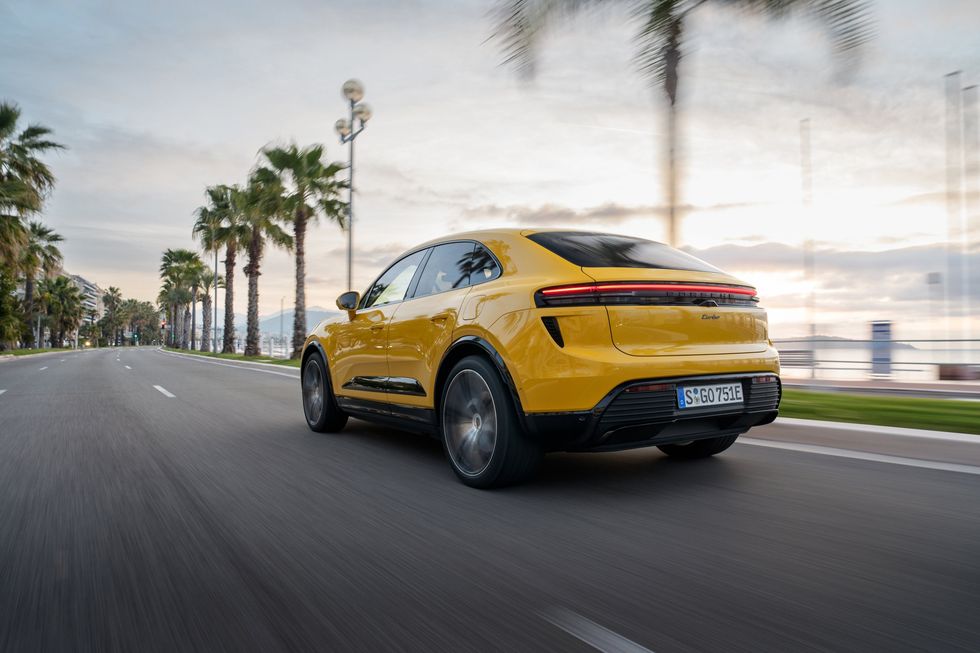
While we never found much wrong with the seating position of the gas-powered Macan, the electric versions, the Macan 4 and the Macan Turbo, sit 1.1 inches lower in front and 0.6 inch lower in the rear seat. Anyone familiar with the gas-powered Macan is unlikely to notice the seating-position difference, but they will likely suspect that they're in an updated Macan. The gauge cluster is now a 12.6-inch screen, and there's a 10.9-inch touchscreen in the middle of the instrument panel. For those who want more screens, another 10.9-inch unit in front of the passenger is a $1570 option that will keep your shotgun rider entertained if not carsick. As with all of these passenger-facing screens, the driver's view of it is blacked out when the Macan is out of park, making it impossible to watch "Window Shop with Car and Driver" on YouTube while driving.
There's a simplicity to the rest of the interior, but, thankfully, a volume knob remains and there are physical HVAC controls below the touchscreen. The leather-wrapped dashboard is a rich touch, but the plainness of the design doesn't look expensive, a view perhaps made worse by the black interior of our sample cars. A 3.4-inch wheelbase increase over the old Macan doesn't add up to a vastly larger interior here. Rear-seat room is spacious enough for a six-footer and certainly won't trigger claustrophobics, but the rear seat isn't a cross-your-legs situation if you sit behind an average driver. Just like on a 911, there's a front trunk (or frunk). There's only three cubic feet of space up there, but it checks an electric-car box that the Germans had largely ignored. Most of your stuff will go under the hatch, where there's up to 18 cubic feet of space.
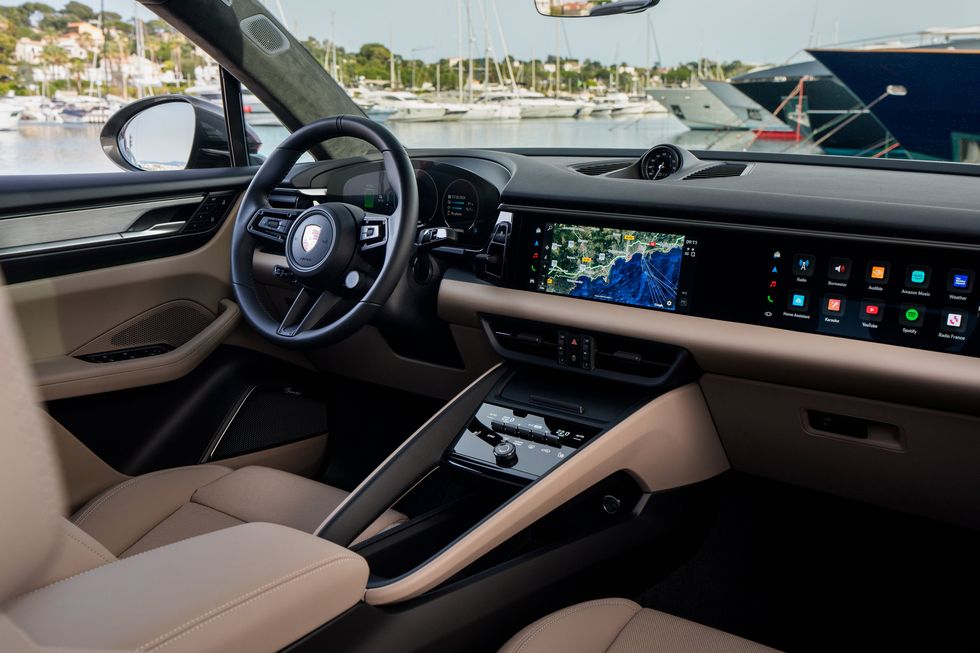
Some electric-car facts: The new platform has a 95.0-kWh battery pack living under the floor and provides a Car and Driver–estimated 250 to 300 miles of range. Like the Taycan, the electric Macan has an 800-volt architecture that enables fast-charging. Porsche says it'll run from 10 to 80 percent charge in the time it takes to watch an episode of Seinfeld without commercials—actually, Porsche said about 21 minutes. On a slower AC connection, the onboard charger can take in as much as 11.0 kW, so figure on about 10 hours from empty to full.
Those numbers out of the way, let's discuss what a Macan without an engine is like to drive. First off, it's quiet. The Macan 4 and the Macan Turbo we drove both were fitted with optional thermal and acoustic glass ($920), which helped keep sound levels low. For $490, you can select Electric Sport Sound, which offers a louder buzzy, wooshy soundtrack for the driving experience. We tried it, started to get a headache, took a couple of Advil, then switched it off. Save your money.
Both the 402-hp Macan 4 and the Turbo share their 234-hp front motors. While the 4 gets by with a 375-hp rear motor, Porsche bolts in a more powerful 630-hp rear unit into the Turbo that confusingly never makes 630 horsepower on its own, but combined with the front unit makes 630 horsepower. Getting maximum power from either requires engaging launch control, which can be done only from a stop. Do so and you get 10 seconds of overboost. In normal driving, the 4 makes 382 horsepower with Turbo making 576 horses.
Instant torque—479 lb-ft in the 4 and 811 in the Turbo—gives an immediate response to the slap of the accelerator, but the 4 doesn't impress off the line. Porsche says the 4 is good for a 4.9-second time to 60 mph, and in a world of very quick EVs, that doesn't feel very quick. The Turbo will snap necks with a claimed 3.1-second 60-mph time.
Electric cars that accelerate as hard as sports cars or even supercars aren't surprising anymore. What the Macan does that few, if any, other battery-powered SUVs can do is handle. Bend it into a corner, and, despite a curb weight on the wrong side of 5000 pounds, the 5.5-inch-lower center of gravity helps mitigate the mass.
Both models have eager steering (electric Macans have a 15 percent quicker steering ratio) with natural weighting, and both try their best to unbend corners. Rear-axle steering is optional on both models, and the system works to stabilize the rear end at speed. At low speeds it cuts the turning circle down to a carlike 36.4 feet. Both the 4 and the Turbo will have adaptive dampers and adjustable air springs as standard. Body control is taut and contributes to the driver's confidence to push toward the cornering limits. An active rear differential that allows for torque vectoring is standard on the Turbo.
Ride quality is supple but not cushy. If you're seeking isolation and a delicate ride, the much-larger BMW i7 will make you smile. If you're about to comment that the i7 isn't a direct competitor, well, what is? When it arrives at this fall, the electric Macan won't face much competition. Mercedes's EQE SUV perhaps comes closest in size and price, but it seems to have been designed to isolate rather than engage. A Tesla Model Y or even a Model X are the same shape, but again, they lack the driving joy that makes the Macan entertaining. Acura's ZDX promises to challenge the battery-powered Macan, but we're still a few weeks away from experiencing it. And then there's BMW’s new iX3, which is still months away. For the first time, Porsche might find a direct competitor from Hyundai and its 641-hp Ioniq 5 N.
How We'd Spec It: The 2024 Porsche Macan EV
In Europe, the gas-powered Macan will no longer be sold, but U.S. customers will continue to have a choice of gas or electric Macans. The gas-fired ones will continue on the old platform, virtually unchanged. Anyone deciding between the two will look at the prices and notice that the electric Macan appears to command a major premium, but if you compare the Macan 4 to its gas equivalent, the 375-hp Macan S, the difference works out to be $6500. The 630-hp Turbo doesn't line up with any of the gas versions and would be $18,500 more than the 434-hp V-6-powered GTS. We still love the sound and the experience of accelerating with a gas-engine Macan, but the new Macan works well as an electric. It looks more modern inside and out, and, like the Taycan, the Macan 4 and Turbo have more than just acceleration to make you smile. And that's rare in today's electric-car world.
Specifications 2024 Porsche Macan EV
Vehicle Type: front- and rear-motor, all-wheel-drive, 5-passenger, 4-door wagon
PRICE
Base: Macan 4, $80,450; Macan Turbo, $106,950
POWERTRAIN
Front Motor: permanent-magnet synchronous AC, 234 hp, 229 lb-ft
Rear Motor: permanent-magnet synchronous AC, 375 or 630 hp, 428 or 605 lb-ft
Combined Power: 402 or 630 hp
Combined Torque: 479 or 833 lb-ft
Battery Pack: liquid-cooled lithium-ion, 95.0 kWh
Onboard Charger: 11.0 kW
Peak DC Fast-Charge Rate: 270 kW
Transmissions: direct-drive
DIMENSIONS
Wheelbase: 113.9 in
Length: 188.4 in
Width: 76.3 in
Height: 63.8 in
Cargo Volume, behind F/R: 44–47/16–18 ft3
Front-Trunk Volume: 3 ft3
Curb Weight (C/D est): 5250–5400 lb
PERFORMANCE (C/D EST)
60 mph: 2.9–4.7 sec
100 mph: 10.6–12.4 sec
1/4-Mile: 11.2–13.5 sec
Top Speed: 136–161 mph
EPA FUEL ECONOMY (C/D EST)
Combined: 75–90 MPGe
Range: 250–300 mi
Source: caranddriver.com
2024 Mercedes-AMG CLE53: The Coupe, Made Swole
"We're going to pump—[clap!]—you up!" One imagines Hans, Franz, and all their pals at AMG reacting thusly to the new Mercedes-Benz CLE coupe, which debuted last summer in four-cylinder CLE300 and six-cylinder CLE450 form. After a muscle-building regimen at AMG HQ in Affalterbach, the result is the Mercedes-AMG CLE53.
The vertical-slat grille may be the first-noticed telltale that this is the AMG version, but the more transformative elements are the swollen front and rear fenders that accommodate similarly wider tracks, by 2.3 inches in front and 3.0 in back, compared to the regular CLE coupe. Additionally, the AMG-specific front fenders allowed the CLE53's front wheels to move 0.4 inch forward, giving the car a fractionally longer wheelbase. The lower front air intake also grows larger, the reshaped hood incorporates a functional vent, sill extensions protrude from the lower body, there are quad exhaust outlets, and the decklid sprouts a small ducktail spoiler. The optional AMG Performance Studio package adds a rear diffuser, a larger rear spoiler, and tweaks to the front fascia. The sum total of the changes gives this car some visual menace, and the available matte paint finish really helps that vibe.
What Motivates the CLE53
The CLE53 doesn't follow the lead of the Mercedes-AMG C63 sedan, which employs a highly complex turbocharged four-cylinder plug-in-hybrid powertrain. Instead, it sticks with a turbocharged and supercharged 3.0-liter inline-six. As in the CLE450, the turbo six is aided by a 48-volt hybrid system, but the AMG version kicks things up a notch. In the CLE53, it's energized with 443 horsepower and 413 pound-feet of torque—with an overboost function adding another 30 pound-feet for up to 10 seconds. Those are hearty increases over the Benz variant (375 horses, 369 pound-feet) and also represent a bump of 14 horses over the previous "53" models. The extra output comes courtesy of a new electrically driven turbocharger that increases boost pressure and provides the overboost function. Additional changes include new piston rings and revamped inlet and outlet channels.
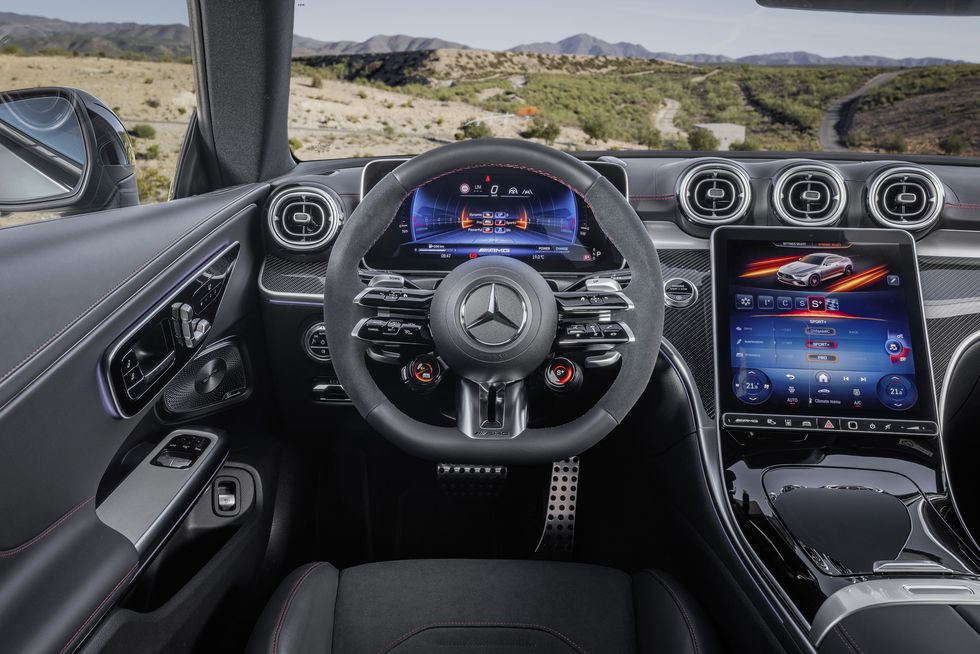
While the rival BMW M4 offers a manual transmission, AMG has no interest in manuals, and there isn't one here. Shifting duties are handled by an AMG-modified nine-speed automatic that, unusually for AMG, retains a torque converter. Even without a clutch pack, however, it still incorporates a Race Start function, which is accessible in Sport mode and above, simply by holding the brake and mashing the gas. All-wheel drive is standard, as it is in all CLE models, and AMG's rear-biased system can decouple the front axle and send 100 percent of the grunt rearward. Spec the AMG Dynamic Plus package, and you get a Race drive mode in addition to Comfort, Sport, Sport+, Individual, and Slippery. Within Race, a Drift function can be unlocked, though it's a multistep procedure. The package also includes adaptive engine mounts and red brake calipers. All CLE53s have the same brake hardware, however, with 14.6-inch vented front discs squeezed by four-piston calipers and 14.2-inch vented rear discs. An AMG Driver's package available in other markets raises the speed limiter from 155 mph to 168 mph, but it won't be offered in the U.S.
Driving the CLE53
The boosted six fires up without the throat-clearing of AMG's V-8s, and even with the active exhaust switched into its more vocal program, there's only the faintest burble when lifting off the throttle. Still, the engine sounds great as it climbs the tach, and we don't miss the theatricality—although some might. The powertrain is plenty strong, with AMG quoting a 4.2-second zero-to-60-mph time and 4.0 seconds with Race Start. That strikes us as conservative; we expect a number in the high threes.
We drive a nearly endless series of curves climbing up and down the mountains in Tenerife, Spain, with zero runoff and only occasional guardrails, and the CLE53's helm provides a welcome measure of feedback, more notably in Sport and Sport+. This marks a real improvement over the standard CLE coupe. We'd wish only for a greater buildup of effort when winding on more lock. Powering out of slow corners, the more rearward torque bias in the sportier drive modes also can be felt, and the standard rear-wheel steering, which turns the rear wheels opposite the fronts by up to 2.5 degrees at speeds up to 60 mph, sharpens cornering response. AMG fits the CLE53 with steel springs and adaptive dampers, which vary in stiffness based on the drive mode. Firm body control is to be expected in an AMG product, and you'll find that here. Stray from Comfort mode, however, and you'll also feel some ride harshness.
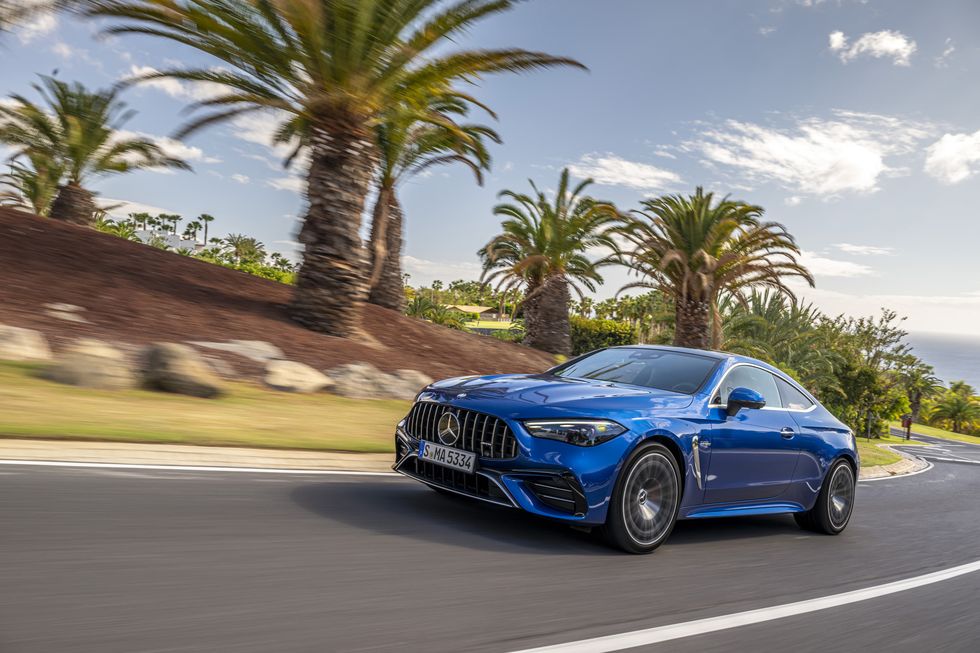
The car we drove had the optional AMG Performance Seats, which are firmly padded and narrow at the hips, but they do hold you in place—and without the sadism of the most extreme BMW M chairs. The driver looks out over an AMG-specific hood with twin raised bulges. In tight corners, you find yourself peering around the beefy A-pillars, and as you might expect, rearward visibility through the dramatically sloping back glass is not great.
The AMG-specific steering wheel includes two dials to switch among the overall drive modes or individual parameters (exhaust, suspension, etc.). The CLE53's 12.3-inch instrument screen allows the driver to keep tabs on additional performance metrics compared to the regular CLE, but the 11.9-inch center touchscreen with the third-gen MBUX system is essentially the same as in the Benz coupe and C-class sedan. This infotainment can't match the ease of use of BMW's 4-series, and the touch-sensitive buttons and sliders are not ideal during high-intensity driving.
Currently, this is the sole Mercedes-AMG two-door other than the SL and AMG GT sports cars. Looking at competing coupes, the CLE53 lines up nicely against the Audi RS5 but isn't as powerful as the BMW M4, nor is it as hardcore as the M4's CS and Competition variants. However, while this is the first time AMG laid its hands on the new coupe, it may not be the last—we anticipate a CLE63 variant will join at some point. A more steroidal AMG CLE may be in the offing, but the gym-toned CLE53 successfully brings a dose of the brand's characteristic swagger to Benz's mid-size two-door.
Specifications
2024 Mercedes-AMG CLE53
Vehicle Type: front-engine, all-wheel-drive, 4-passenger, 2-door coupe
PRICE (C/D EST)
Base: $80,000
ENGINE
supercharged, turbocharged, and intercooled DOHC 24-valve inline-6, aluminum block and head, direct fuel injection
Displacement: 183 in3, 2999 cm3
Power: 443 hp @ 6100 rpm
Torque: 443 lb-ft @ 2200 rpm
TRANSMISSION
9-speed automatic
DIMENSIONS
Wheelbase: 113.2 in
Length: 191.0 in
Width: 74.2 in
Height: 56.5 in
Passenger Volume, F/R: 55/37 ft3
Trunk Volume: 15 ft3
Curb Weight (C/D est): 4400 lb
PERFORMANCE (C/D EST)
60 mph: 3.8 sec
100 mph: 9.8 sec
1/4-Mile: 12.2 sec
Top Speed: 155 mph
EPA FUEL ECONOMY (C/D EST)
Combined/City/Highway: 23/20/28 mpg
Source: caranddriver.com
The new Honda Prelude will have a hybrid drive and over 200 "horses"
At last year's Tokyo Motor Show, Honda surprised everyone by revealing the Prelude concept. The company has already confirmed that the production version will be a hybrid-powered coupe, and Best Car Web now provides insight into new details on the car's powertrain, dimensions and price.
It was previously known that the production Prelude would have a hybrid powertrain, which chief engineer Tomoyuki Yamagami said would serve as a "prelude" to Honda's future electric vehicles.
Best Car believes it will have the same 2.0-liter four-cylinder e:HEV engine that powers the Civic Hybrid, with a total combined output of 207 hp.
The Prelude will reportedly be 4,300mm long, 1,790mm wide and 1,300mm tall, while the wheelbase will be 2,575mm.
That makes it bigger than the Mazda MX-5 Miata, unsurprisingly, and almost identical to the Toyota GR86.
Honda is reportedly positioning it as a premium model above the aforementioned Toyota.
In Japan, the new Prelude will reportedly cost between $27,300 and $29,300. By comparison, the GR86 costs $18,900-$23,400 in the same market.
It is expected to arrive in showrooms by the second half of 2025.
Volkswagen Touareg R review
The most powerful car in the entire Volkswagen line-up is this model, the Touareg R. This dynamic 462PS luxury large SUV was the first of the brand's sporting R models to feature plug-in drive. And it was the first all-wheel drive model in VW's PHEV range. Here's the improved version.
Background
The Touareg R is a step beyond any version of Volkswagen's largest SUV that we're previously seen. It's also a very different car from any that the Wolfsburg marque's 'R' sub-brand has attempted to develop before, taking its place above the T-Roc R and Tiguan R performance SUV models that the brand's R division launched before it.
Before we first saw this Touareg R in 2020, some had expected this fastest Touareg to use the fiery 600PS mild hybrid petrol V8 from the Audi RS Q8. Or perhaps the 435PS V8 BiTDI diesel engine from the Audi SQ7. The 462PS petrol V6 it arrived with instead turned out to be more than sufficient to justify the 'R' branding. Unlike the two other engines just mentioned, this one is a plug-in hybrid powertrain - essentially the same unit used by the Porsche Cayenne and the Bentley Bentayga, but delivered here without the six-figure price tag. This model's mid-term update in mid-2023 brought a slightly sharper look, bigger wheels and a higher price tag.
Driving Experience
There are no significant changes under the bonnet with this improved Touareg R. Which means that, as before, there's a turbocharged 2.9-litre V6 petrol engine with 340PS mated to an electric motor contributing a further 136PS that's situated between the engine and the 8-speed Tiptronic auto gearbox and is powered by a 14.1kWh lithium-ion battery beneath the boot floor. The two drive systems can be combined in a 'boost' function when required - for instance when overtaking - and when this happens, you get a full system output rated at 462PS, along with 700Nm of torque. Air suspension and adaptive damping are standard. Unlike the Golf R and T-Roc R models, there's no 'Race' mode for high performance driving but you'll still be going pretty quickly. Rest to 62mph can be dispatched in around 5 seconds on the way to 155mph.
When you're not seeking outright performance, you can select the fully-electric 'E-Mode', which allows for battery-powered driving at speeds of up to 87mph - though obviously, if you even approach that sort of velocity with any regularity, you won't get anywhere near the WLTP-rated electric driving range capability - quoted at 28 miles. So that potential owners can retain the usual Touareg's full 3.5-tonne towing weight, this R variant keeps the conventional model's Torsen-equipped 4MOTION 4WD system with its various tarmac and off road drive settings. For regular 'off piste' use, you'll need the optional 'Off-Road Package', which brings improved under-body shielding and extra traction control settings for driving on sand, mud and gravel.
Design and Build
Visual changes to this improved model are slight: basically larger lower front bumper air ducts and revised headlights. Plus as part of this update, you get larger 22-inch 'Estoril' diamond-turned alloy wheels. As before, from the outside this top Touareg sets itself apart from humbler variants with various little touches - R-style bumpers, black louvres in the air intake grilles, black trim strips on the side windows, black mirror housings and a radiator grille with black trim strips. Plus if you should miss all of that, there's a pair of large trapezoidal tailpipes to clue lesser drivers in on what's just flashed past them.
Inside, the enhancements are equally subtle. Things like embossed R logos for the unique sports steering wheel and for the head restraints of seats trimmed in Vienna leather upholstery with 'Crystal Grey' stitching. 'Silver Wave' aluminium decorates the dash and the doors and you get brushed stainless steel pedals and cool white background lighting. As in top versions of the standard model, there's a huge 15-inch infotainment display on the centre stack and a 12-inch digital instrument cluster. As part of this update, the central infotainment monitor has had software and functionality updates which have brought more advanced HD map data, plus an updated voice control system and wireless 'Apple CarPlay/'Android Auto' smartphone-mirroring.
As usual on a Touareg, there's a comfortable back seat with sliding and seat reclining options. Luggage space, accessed via a powered tailgate and a stainless steel load sill protection plate, is slightly compromised by the PHEV system's battery, so is down from 810 to 610-litres. Think in terms of around 1,600-litres with the seats down.
Market and Model
The most expensive versions of more conventional Touaregs already cost around £70,000, so you'll need to think in terms of needing a budget of around £80,000 for a Touareg R, which is about the same as you'd pay for an identically-engineered Porsche Cayenne E-Hybrid. Console yourself with the thought that an identically-engineered Bentley Bentayga PHEV could cost you nearly twice as much.
Obviously, the standard spec is comprehensive, including 22-inch 'Estoril' diamond-turned wheel rims with blue calipers and decorated with a silver R logo. Also included are iQ.Light LED matrix headlights, a panoramic sunroof, 4-zone air conditioning, a special sports steering wheel and unique upholstery. The 'Innovision' in-car screen package gives this model a 15-inch central touchscreen and a 12-inch digital instrument binnacle display. Plus there's also the latest version of Volkswagen's 'Travel Assist' adaptive cruise control system which can accelerate, steer or brake this Touareg at speeds of up to 155mph. Options include a 780-watt sound system and Night vision (which detects people or animals in the dark using a thermal imaging camera).
Camera-driven safety features include 'Front Cross Traffic Assist' - which responds to traffic crossing in front of the car. For autonomous driving, there's 'Traffic Jam and Roadwork Lane Assist' which offers partly automated steering and lane departure warning up to 37mph, plus autonomous acceleration and braking.
Cost of Ownership
Not surprisingly, the efficiency specs here are much the same as those of this model's near-identically-engineered direct cousin, the Porsche Cayenne E-Hybrid. So think of a set of WLTP figures claiming this car to be capable of up to 122.8mpg on the combined cycle and up to 53g/km of CO2. As with all PHEVs, these are pie in the sky figures, but at least the emissions reading will mean substantial BiK tax savings over a comparable diesel model. A mode 3, 32 A / 7.2 kW charging cable is included to top up the battery from public charge points. Charging an empty battery in this way will take two and a half hours, while using a household three-pin socket will take eight and a half hours. Empty to full charging takes around 4 hours from a 7kW garage wallbox - or up to 6 hours from a domestic plug.
As usual with a PHEV, there's the option of saving battery charge for later in your trip (urban driving you might have to complete at the end of a long motorway journey for instance. And if the plug-in system's 14.1kWh battery is running low, you can (rather inefficiently) charge it using the V6 petrol engine as a generator. It's better though, to try and cope by simply increasing the level of regenerative braking. As for servicing, well as usual with Volkswagen models, there's a choice of either 'Fixed' or 'Flexible' maintenance packages. You'll choose the 'Fixed' approach if you cover less than 10,000 miles a year and with this, the car will typically be looked at every twelve months. If your daily commute is more than 25 miles and your Touareg will regularly be driven on longer distance journeys, you'll be able to work with a 'Flexible' regime that can see you travelling up to 18,000 miles between garage visits - or every two years, whichever is sooner.
Summary
This potent plug-in powertrain suits this ultimate Touareg very well. If you want more straight-up power from a Volkswagen Group-engineered premium large SUV, there's always the Audi RS Q8: if you want more torque, there's always the Audi SQ7. But those two models look a little one-dimensional alongside this one. A Touareg R, after all, has much more to offer than just barnstorming performance. At one extreme, there's the potential for largely fuel-free near-silent commuting. At the other, this car's capable, when properly equipped, of dealing with the kind of challenging off road track you might hesitate to attempt in a Land Rover product. And in between, it's capable of scaling sixty from rest as quickly as would a Porsche 718 Cayman sports car.
There's something very appealing about a product like that. Particularly one that also comes with the warm eco-centric glow you get these days from choosing something electrified. A car with super-affordable tax liability. And a set of fuel and CO2 stats that'll stop Greenpeace carpers in their tracks. Yes, it'd be nicer to have a Bentley Bentayga or Porsche Cayenne with this same tech. But a Touareg R makes so much more financial sense. We think you'd like one.
Source: rac.co.uk
Skoda Kodiaq SUV (2024) review: as dependable as ever
The new Skoda Kodiaq Mk2 looks a lot like the Mk1, because it is. Any why wouldn’t Skoda stick closely to a winning formula? Since 2016, when it was launched, Skoda has shifted more than 860,000 Kodiaqs. Britain is the second-largest market, behind Germany and ahead of the car’s native Czech Republic.
It’s done so well because it’s always been a keenly priced large family car, offered with five or seven seats. It shares many of its qualities with the Superb estate: easy to get on with, brilliant room in the back, decent to drive.
It relies heavily on technology from parent company VW, but has generally been perceived as being a better package than in-house rivals such as the Seat Tarraco and the now departed VW Tiguan Allspace.
At a glance
Pros: Massively flexible, lots of spec choice, sensible interior, smooth to drive
Cons: Not as good value as it used to be, not particularly exciting
What’s new?
The new Kodiaq is longer and roomier, for passengers and luggage alike. It has some significantly new elements in the cabin, with a greater emphasis on sustainability.
There are new lights, a new logo, a new grille with new air intakes underneath, a new spoiler sticking out the back of the lengthened roof, and some new colours. Put them side by side and you won’t have to think twice about which is the old one and which is its replacement. There are new alloy wheels, from 18 to 20 inches.
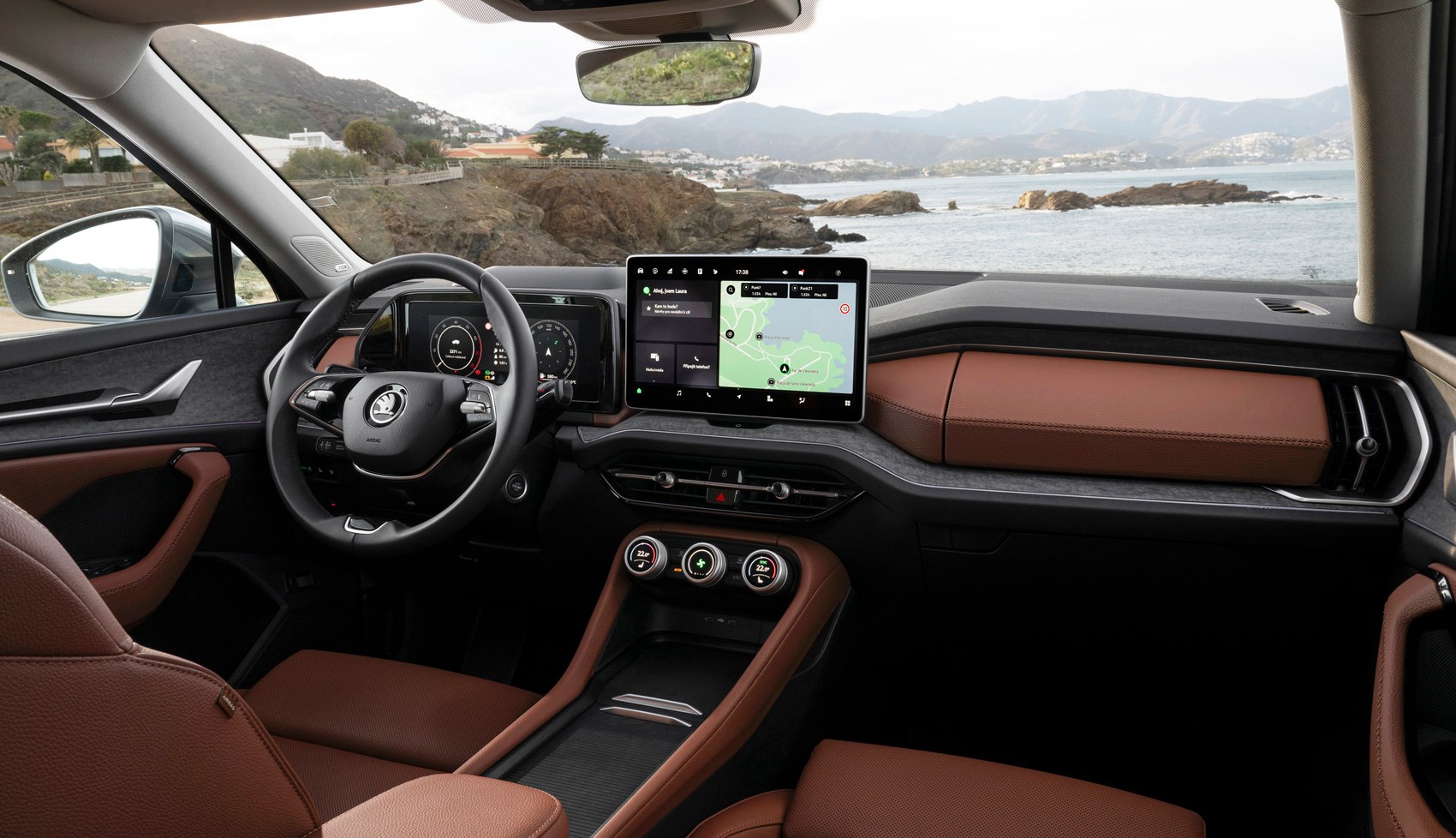
But visually it’s more of the same: not exactly handsome, and not a world apart from various Seat, VW and Audi products, but it succeeds in looking smart, modern, functional and stylish enough.
What are the specs?
Initially there are two spec levels, SE and SE L. Sportline will be along soon, with marginally more visual pizzazz. And later there will be a vRS version.
SE comes with 18-inch wheels, front and rear LED lights, heated front seats and three-zone climate control, plus a bunch of safety-enhancing electronics. SE L – priced from £40,205 – has 19-inch wheels as standard, adaptive matrix LED headlights, an electronically adjustable driver’s seat and electric boot opening. There are also various interior design packages available, called ‘selections’, following the pattern established by the Enyaq.
There are several engines to pick from: a 148bhp mild-hybrid 1.5-litre petrol four-cylinder, a 201bhp 2.0-litre TSI (which is all-wheel-drive only), a 148bhp 2.0-litre diesel four and a 190bhp version (the latter being only for all-wheel drive). Some models are available with DCC adaptive suspension, which when set in Sport mode adds a welcome firmness.
The PHEV is front-wheel drive and five seats only. It has a six-speed DSG automatic transmission, where the others all have seven speeds. But there’s no electric option. If you want a Skoda SUV with EV propulsion, you need to be looking at the Enyaq.
What about the interior?
The best thing about the Kodiaq. There’s nothing radically different or innovative, but it’s a very successful mix of familiar and new, of traditional and advanced.
It’s still very roomy – in fact slightly roomier than before, with an expanded boot and more headroom for those in the third row, while having a sleeker shape that has reduced aerodynamic drag.
If you go for seven seats you get less boot space than five-seaters, and if you go for the plug-in hybrid version you get less luggage capacity than those opting for versions that don’t have a big battery under the floor. But even the least capacious boot is still usefully roomy, and the largest is cavernous: 910 litres with the second row in use, and 2105 litres with them folded down, which is done with a simple flick of a lever.
The passenger seats split 60:40, and can be slid forwards or back to give more boot space or more legroom. Even with the front seats back and the back seats forwards, adults will be comfortable.
Rear passengers get heating controls and chargers plus a centre console of sorts, with oddments space and two cupholders. This can be removed if an adult is going to sit in the middle seat.
Up front the centre console is a masterclass in practicality. As the new Kodiaq is not available with a manual gearchange, the selector has been moved to the steering column, freeing up lots of space, which Skoda’s interior designers have used well. There are up to four cupholders, depending how you choose to arrange it, plus wireless charging areas for two phones, a couple of C-USB ports, and a lot of space in the armrest.
The dashboard now hosts a 13-inch central touchscreen, which is logically laid out and configurable. It can be largely ignored on the move, thanks to three physical multi-purpose dials below the screen, which between them control functions including driving modes (on those models that have modes), volume and heating. It’s an intuitive, effective arrangement.
The steering wheel isn’t overburdened with controls, but those that are present are easy to operate without taking your eyes off the road. The wheel itself may look as though it’s flat-bottomed, but that’s an illusion – it’s actually round, with a decorative protrusion around the 6 o’clock mark.
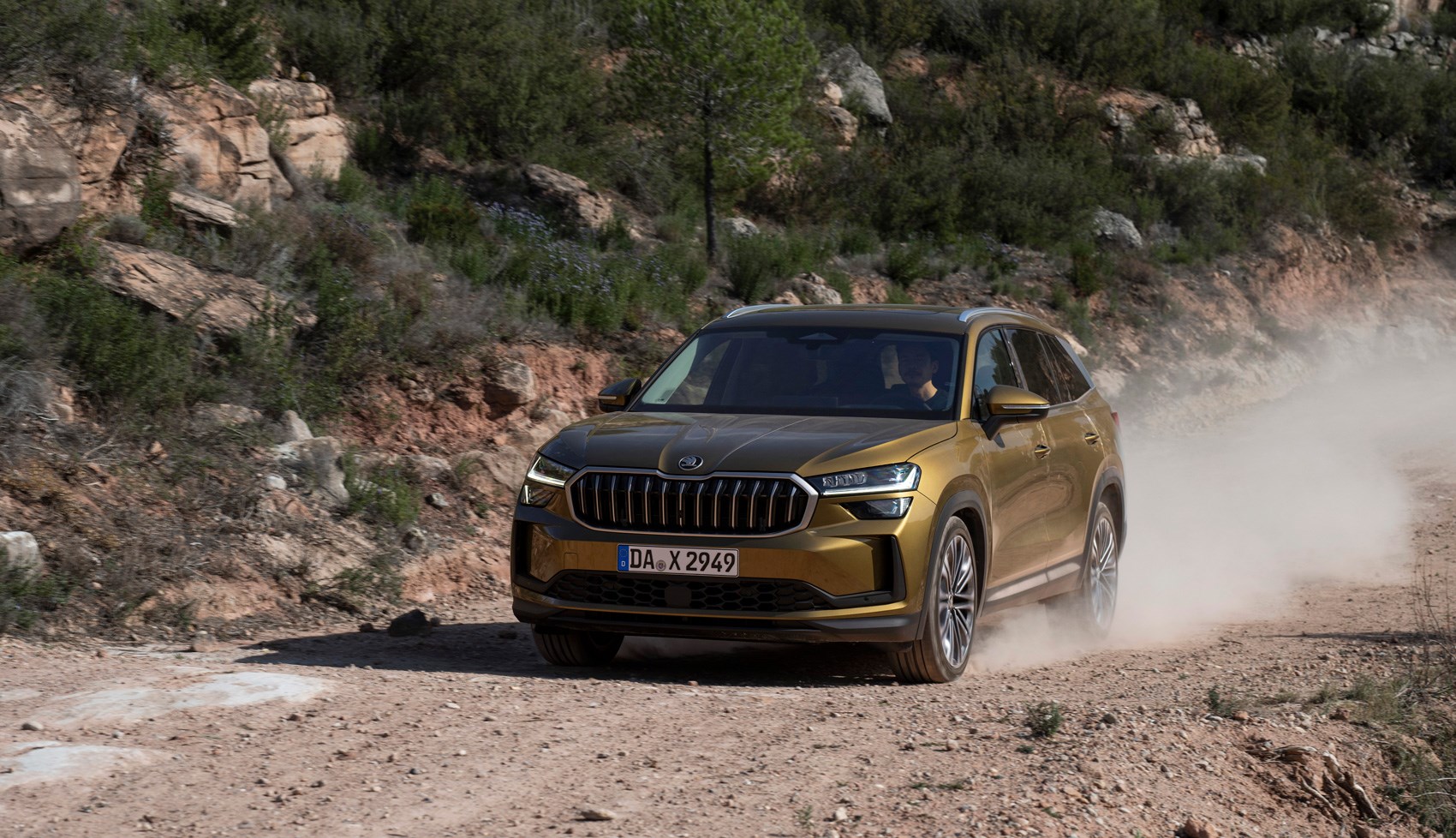
The doors have those useful removable rubbish bins for sweet wrappers and the like in their pockets, and slotted into the driver’s door itself is an umbrella – a familiar Skoda touch, along with the ice scraper clipped into the fuel filler cap. A new detail, along similarly user-friendly lines, is the cap on the screenwash reservoir under the bonnet. It opens up into a funnel that will reduce the amount of wasteful splashing.
Interior fabric choices include a really nice material that is made of recycled plastic, and leather that is treated with coffee-bean waste, rather than chemicals, in the tanning process.
A head-up display is now available, and there’s the option of a big glass sunroof to bring a bright ambience to the cavernous cabin. Despite its size, it doesn’t sound boomy or creaky, thanks to a combination of effective sound-deadening and sturdy construction.
How does it drive?
We’ve sampled four versions so far: two diesels, the mild hybrid and the plug-in hybrid. They weren’t in complete alignment with UK spec, but close enough for us to be pretty confident about their respective strengths and weaknesses.
The mild hybrid, which we drove on a demanding route involving many hairpin bends and some fast motorway miles, returned an impressive real-world 35mpg. But as you might expect from a 148bhp motor in such a big car, it doesn’t offer scorching performance. On those hills, it wasn’t exactly struggling but it certainly wasn’t shining. In more typical family driving, it’s smooth, lively enough and easygoing.
The plug-in hybrid is much perkier, reflected in a 0-62mph time that, at 8.4 seconds, is 1.3 seconds quicker. And if it replicates the official figures, it will top 60 miles of electric-only running, using its 25.7kWh battery, and recharge quickly. But a much longer drive will be needed to check that out.
Quite possibly the sweet spot in the range is the lesser of the two diesels. In five-seat SE guise, it costs £38,945 and combines a 9.6sec 0-62mph time with economy around 50mpg. Its torquey nature makes it feel faster than that, and it’s untroubled by hills or heavy loads. The more powerful diesel is faster off the line, with a 7.8sec sprint time, but it’s thirstier, has a higher CO2 output, and currently only comes as a seven-seat 4×4 in SE L trim, which pushes the price to £56,225.
All this talk of performance is pretty much beside the point. The Kodiaq is not designed to by dynamically outstanding, and is at its best when it’s used for its core tasks of family holidays, the school run, shopping and taking vast quantities of garden waste to the tip.
Ride quality is good, but the body gets wobbly if you hammer it hard through the bends. And the steering is always a little vague and remote. That may change when the vRS version arrives, but for now the Kodiaq is going to bring at least as much pleasure to the passengers as to the driver.
Verdict: Skoda Kodiaq
The Kodiaq shows Skoda doing typical Skoda stuff very well. The details are fantastic, the refinement is good, it drives well but not brilliantly, and it gives off a general feelgood vibe rather than any eruptions of excitement.
There are plenty of choices for buyers wanting family-friendly SUVs, and this remains among the best, certainly when you factor in the cost. Its pricing undercuts the seven-seat Hyundai Santa Fe. The Mercedes GLB, Peugeot 5008 and Land Rover Discovery Sport are classy seven-seat alternatives, but not as roomy.
And if you don’t want seven seats, you have a huge variety of alternatives. Don’t overlook Skoda’s own similarly priced Superb estate, which has the same clever design, technology and detailing as the Kodiaq, but a little more to engage the driver too.
That said, the Kodiaq is a very pleasing all-round package, with the prospect of better versions still to come.
Specs
Price when new: £36,645
On sale: Now
Engine: 1498cc mild-hybrid turbocharged four-cylinder, 148bhp @ 5000rpm, 184lb ft @ 1500rpm
Transmission: Seven-speed dual-clutch automatic, front-wheel drive
Performance: 9.7sec 0-62mph, 129mph, 42.8-47.8mpg, 135-151g/km CO2
Weight / material: 1586kg/steel
Dimensions (length/width/height in mm): 4758/1864/1659
Source: carmagazine.co.uk



